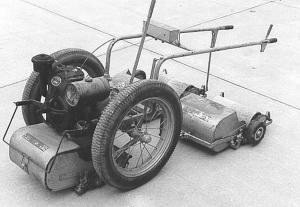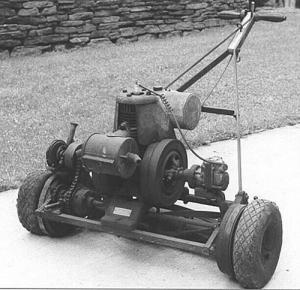Museum Holds Hundreds Of Vintage Reel Mowers
In 2008 James Ricci had amassed such a large collection of reel lawn mowers that he launched a business and website called The Reel Lawn Mower History and Preservation Project. His idea was to preserve and expand knowledge of vintage mowers of the 19th and early 20th century.
Since he started collecting reel mowers in the late 80’s, Ricci has acquired hundreds of different models representing 25 different manufacturers. “Some of them I’ve bought or traded for at swap meets,” says Ricci. “I’ve also had about 250 old mowers given to me over the years.”
Ricci says reel mowers came to the U.S. in the mid 1800’s when a few different models were imported from England. That coincided with people learning that an attractive mowed lawn enhanced the landscape around a home. By the end of the 1800’s, well over 150 companies were making reel mowers in the U.S.
At Ricci’s North Farms museum he has push-type hand reel mowers from 5 different companies, pull-type gang mowers from 2 companies, and power reel mowers from 18 different companies.
Ricci says the reel-type mower was invented by Englishman Edwin Beard Budding in 1830, who at the time was working in a textile mill in Gloucester. His machine was originally designed to trim the knap off cloth uniforms. Soon he realized it would also cut grass. Friends and co-workers thought he was a madman for needing two people to mow a lawn, one pushing and one pulling, so he tested his invention on lawns during nighttime hours to avoid being called a lunatic. Beard, however, had the last laugh as his invention became a huge success. His cylinder cutting principal hasn’t changed in more than 180 years and the manicured look it produces is preferred by golf courses, Royal palaces, bowling greens and athletic fields.
“England has a much larger base of mower collections than the U.S,” Ricci says. “They have many manufacturers and collectors there value the different styles, sizes and power options.”
Ricci says that early mowers, including large riders, were built with big and heavy cast iron pieces. “Cast iron was easy to work with and many towns had foundries, so parts and mowers were easy to make. They weren’t concerned about soil compaction, so weight wasn’t a problem either. That’s not the case today where users want lightweight equipment that mows, collects, mulches and still produces a manicured look.”
Contact: FARM SHOW Followup, James Ricci, 30 North Farms Road, Haydenville, Mass. 01039 (ph 413 268-7863; www.reellawnmower.com).

Click here to download page story appeared in.
Click here to read entire issue
Museum Holds Hundreds Of Vintage Reel Mowers FARM HOME Lawn Mowers 31h 38 In 2008 James Ricci had amassed such a large collection of reel lawn mowers that he launched a business and website called The Reel Lawn Mower History and Preservation Project His idea was to preserve and expand knowledge of vintage mowers of the 19th and early 20th century Since he started collecting reel mowers in the late 80’s Ricci has acquired hundreds of different models representing 25 different manufacturers “Some of them I’ve bought or traded for at swap meets ” says Ricci “I’ve also had about 250 old mowers given to me over the years ” Ricci says reel mowers came to the U S in the mid 1800’s when a few different models were imported from England That coincided with people learning that an attractive mowed lawn enhanced the landscape around a home By the end of the 1800’s well over 150 companies were making reel mowers in the U S At Ricci’s North Farms museum he has push-type hand reel mowers from 5 different companies pull-type gang mowers from 2 companies and power reel mowers from 18 different companies Ricci says the reel-type mower was invented by Englishman Edwin Beard Budding in 1830 who at the time was working in a textile mill in Gloucester His machine was originally designed to trim the knap off cloth uniforms Soon he realized it would also cut grass Friends and co-workers thought he was a madman for needing two people to mow a lawn one pushing and one pulling so he tested his invention on lawns during nighttime hours to avoid being called a lunatic Beard however had the last laugh as his invention became a huge success His cylinder cutting principal hasn’t changed in more than 180 years and the manicured look it produces is preferred by golf courses Royal palaces bowling greens and athletic fields “England has a much larger base of mower collections than the U S ” Ricci says “They have many manufacturers and collectors there value the different styles sizes and power options ” Ricci says that early mowers including large riders were built with big and heavy cast iron pieces “Cast iron was easy to work with and many towns had foundries so parts and mowers were easy to make They weren’t concerned about soil compaction so weight wasn’t a problem either That’s not the case today where users want lightweight equipment that mows collects mulches and still produces a manicured look ” Contact: FARM SHOW Followup James Ricci 30 North Farms Road Haydenville Mass 01039 ph 413 268-7863; www reellawnmower com
To read the rest of this story, download this issue below or click
here to register with your account number.








